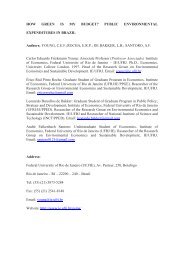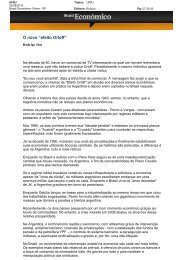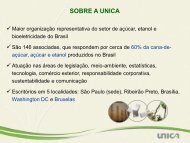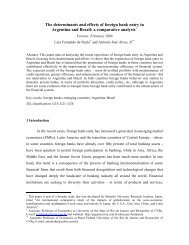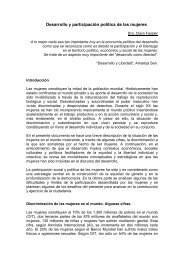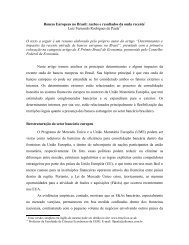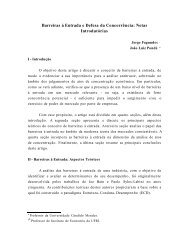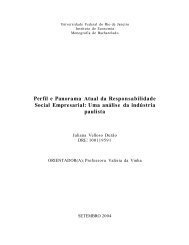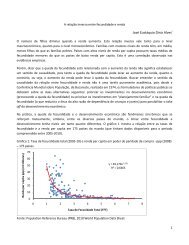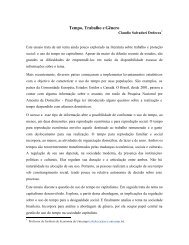Trade Integration for the Americas: What Can Economic Analysis ...
Trade Integration for the Americas: What Can Economic Analysis ...
Trade Integration for the Americas: What Can Economic Analysis ...
- No tags were found...
Create successful ePaper yourself
Turn your PDF publications into a flip-book with our unique Google optimized e-Paper software.
15nonmember – suffers a slight welfare loss as a result of <strong>the</strong> FTAA, stemming from <strong>the</strong>trade diversion associated with FTAA <strong>for</strong>mation.Argentina presents an interesting case with <strong>the</strong> HRTG estimates. It incurs a slightwelfare loss as a result of <strong>the</strong> FTAA. The most plausible explanation <strong>for</strong> this isArgentina’s loss of its privileged position in <strong>the</strong> Brazilian market previously stemmingfrom MERCOSUL trade diversion. The FTAA eliminates this gain <strong>for</strong> Argentina (andloss <strong>for</strong> Brazil). The HRTG result <strong>for</strong> Argentina is not however uni<strong>for</strong>mly obtained ino<strong>the</strong>r analyses. As also seen in Table 5, <strong>the</strong> IDB estimates show welfare gains <strong>for</strong>Argentina emanating from <strong>the</strong> FTAA. A roughly comparable CGE modeling exercisedone by <strong>the</strong> Argentine Government showed a similar welfare gain <strong>for</strong> Argentina fromFTAA accession. 14The IDB estimates tell <strong>the</strong> same basic story. Gains are experienced all around,except <strong>for</strong> <strong>the</strong> (excluded) European Union which incurs a small welfare loss resultingfrom trade diversion. The United States gains, but those gains are quite modest given <strong>the</strong>size of <strong>the</strong> American economy. The Central American and Caribbean countries also gain,but less relatively than in <strong>the</strong> HRTG study. Brazil, on <strong>the</strong> o<strong>the</strong>r hand, shows much largergains than with <strong>the</strong> HRTG estimates. Gains <strong>for</strong> Chile are also significant, but those gainsmay be overstated, because of <strong>the</strong> more recent RTA of Chile with <strong>the</strong> US – not factoredinto <strong>the</strong> analysis.If <strong>the</strong> benefits of <strong>the</strong> FTAA are so apparent <strong>for</strong> prospective member countries,why haven’t <strong>the</strong> negotiations been completed and <strong>the</strong> FTAA enacted? Aside frommisunderstandings, <strong>the</strong> ideological rant, and economic ignorance, <strong>the</strong>re are some genuineeconomic reasons why <strong>the</strong> FTAA has not come into fruition. Those reasons center onprotectionism. Some groups or activities would be negatively affected in all countries,and <strong>the</strong>se vested interests most commonly outweigh in <strong>the</strong>ir political voice and influencethose that would benefit from <strong>the</strong> FTAA. Even though <strong>the</strong> net benefits <strong>for</strong> anyprospective member country may be positive, this by no means assures that <strong>the</strong> politicalprocess surrounding negotiation, agreement and adoption will proceed. Groups opposedto <strong>the</strong> FTAA, <strong>for</strong> whatever reason, have proved effective so far in delaying or derailing<strong>the</strong> discussions. Clearly some of <strong>the</strong> arguments raised in <strong>the</strong> discussions have someeconomic merit; o<strong>the</strong>rs are mostly smokescreens.A major economic issue relates to <strong>the</strong> treatment of agriculture. While <strong>the</strong> USagricultural sector is generally very competitive, <strong>the</strong>re are some agricultural activities inwhich this is less so. In particular, <strong>the</strong> MERCOSUL countries are more competitive inmany gain products. In addition, <strong>the</strong> US heavily subsidizes many agricultural activities.Thus <strong>the</strong> elimination or reduction of agricultural subsidies plus market access <strong>for</strong>agricultural products is an important issue under discussion <strong>for</strong> <strong>the</strong> FTAA. The USposition is that agriculture-related issues are best discussed under <strong>the</strong> coming DohaRound of multilateral trade negotiations, where EU agricultural policies and subsidies14 CEI (2002). With a constant returns to scale assumption and <strong>the</strong> inclusion of trade relate externalities, <strong>the</strong>CEI CGE model simulations show that Argentina reaps a 1.3 percent of GDP gain as a result of <strong>the</strong> FTAA.



